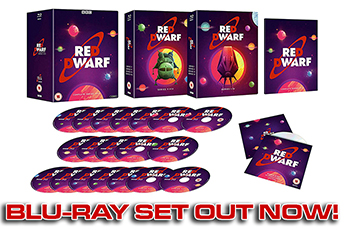 |
Battlefield Flibble He's created effects large and small for Ridley Scott, John Travolta and, of course, Doug Naylor. Down where the cowardly fear to tread - which is to say, an effects shed in Shepperton - Mr Flibble holds up the microphone and prepares to transcribe, through a thick Scottish accent, the words of master of miniatures, Bill Pearson. |

Andrew Ellard
To begin the interview, Mr Flibble asked, "How did you get involved with RED DWARF?"
Through Jim Francis. We first met up at the BBC when he was a visual effects designer in the department, and I was a freelancer . I did work within the BBC for two years in visual effects, and worked with Jim on shows like Captain Zep - Space Detective. Normally when there's any miniatures involved Jim contacts me.
Up until this series [VIII] I'd actually worked on 'Dwarf previously, but it had always been on set dressing [and] some hand props. With the earlier shows, the BBC visual effects department designed and built those pieces. We were dealing directly with [production designer] Mel Bibby. Mel was giving us very accurate drawings for things like the medi-bed.
We did the Back to Reality set. Mel said to me, "Bill, can you do something like that set you did on Alien - the sleep chambers?" I said, "Well, I worked on Alien, but I didn't work on the sets." And he said, "Well, yeah, you know the thing with the petals that come up and they're all lying down? Well if you can do something [like that] where they're sitting, and they've got something that comes up over their faces, and you can put them in a circle." So that was the job description. I just sat down and I did some pretty rough thumb-nails.
How did working on Red Dwarf compare with your time on other BBC shows like Blake's 7, Bugs or Dr Who?
Say, for example, Blake's 7 - most of the work that I did on that was building models, [and] I built some model sets. The same on Dr Who. What was similar was I never had any MONEY! (Laughs) I knew what I was getting into - you know not to expect a large budget. My experience was working in features [like] the original Alien - [in movies] it was an open cheque-book really, you could write out whatever you wanted. The same on Flash Gordon, [and] Outland.
I worked on the first ever episode of Blake's 7 as a freelancer and it was a case of, "Yeah, we need this hand prop - and we've allocated twenty-five pounds for that." (Laughs) You're thinking, "It's going to be a trip down the one-pound shops, or to Halfords..."
But I didn't see any great difference in 'Dwarf. Some people say [about] your work on 'Dwarf, "Oh, it's only a comedy, you can make anything for it and get away with it." Well, I don't believe that is the route to go with comedy. If you can make the surroundings - props, models - as believable as possible, then you're contrasting with the clever dialogue.
Mr Flibble didn't remember his dialogue being particularly clever, then asked: "Are you forever picking up new techniques and methods?"
There are always new things happening - new techniques, new materials. The first job on series VIII was the SKUTTERS, and I only had photographs of the original skutters, and from that it was a case of, "Build us an identical one - but with more functions, and please make it work every time in the studio." Radio control is more advanced now than it was when the Skutters were first built - so you don't get a number 56 bus going past outside screwing up the signal!

With the Skutters I had done some radio-control work before, but I was having to go really in-depth with this. Luckily there was a guy available, Ron Hone, who I'd worked with previously - and he'd worked on R2-D2. So I said, "Ron, come in, and if I don't know something about radio control - of which I'm sure there's plenty - you can help me." So we did that together.
After I finished 'Dwarf I was asked to do Tenth Kingdom, and the job on that was to make a possessed vacuum cleaner; an upright vacuum cleaner that goes wild and starts sucking in carpets and curtains. And it had to be radio controlled. So straight away I was, "Hey, that was good, what I learned on 'Dwarf."
More recently you've been doing miniatures and props for BATTLEFIELD EARTH in Montreal for six months - how has that been?
I was in charge of all the miniature construction, I built a couple of versions of the spaceship - [it was] a bit Starbug-like - which had to be rigged for motion control, so we had to put motors in it to make all the parts move. We made one five feet long and one two and a half feet long.

We had to replicate the city of Denver one thousand years in the future. It's supposed to be [that] the aliens come this year and gas ninety-nine per-cent of the population on the planet - the survivors are in caves, so they're back to Neanderthal-style, primitives; and the cities just stand there and rot.
The Psychlos, the aliens, they encapsulate some of the cities under domes and pump in their own breathing gas, so that they can live in the cities. They're lazy bastards and they only live in the cities so they can tap off the power, the electrical power, hydro-power, so the buildings rot even though they're under these domes. And they're lousy drivers as well. (Laughs) They fly around in these ships and take lumps out the sides of buildings.
 [The models] were nineteen feet tall. We basically made them as real buildings,
and then went around with chainsaws. (Laughs) Once they were completed
we thought, "Right, well, there could be a nasty driver who took that
side out, who crashed right in there." [We] also Psychlo-fied the buildings,
putting a lot of alien technology on them. So, yeah, it was fun when the
chainsaws came out - it's great destroying your work. (Laughs)
[The models] were nineteen feet tall. We basically made them as real buildings,
and then went around with chainsaws. (Laughs) Once they were completed
we thought, "Right, well, there could be a nasty driver who took that
side out, who crashed right in there." [We] also Psychlo-fied the buildings,
putting a lot of alien technology on them. So, yeah, it was fun when the
chainsaws came out - it's great destroying your work. (Laughs)
You'd worked with Battlefield Earth director ROGER CHRISTIAN before, hadn't you?
Yeah, many times. We met on the original Alien. Roger came into the model shop, introduced himself, and said, "I was an art director on the film. I'm working on a film called Life of Brian and I've got to make some sort of spaceship that picks up Brian, flies around and dumps him back. We've got nothing, we've got no money, can you help me out?" I said, "Help yourself." We had thousands of pounds-worth of gear, and we were going to throw it out at the end. We were only about a month away from completion of the miniature work anyway. So he said, "Really?" I said, "Yep, take what you want." He said, "I owe you for this." I said, "Yeah, sure!"
 Well, it was many
years later he contacted me on a film - Lorca and The Outlaws (at the
time it was called 2084) [it was also known as Starship] - and I went
in and worked on that for a few months. And since then, any film that
Roger does he gives me a bell. I did Nostradamus [and] I did Masterminds
with Patrick Stewart.
Well, it was many
years later he contacted me on a film - Lorca and The Outlaws (at the
time it was called 2084) [it was also known as Starship] - and I went
in and worked on that for a few months. And since then, any film that
Roger does he gives me a bell. I did Nostradamus [and] I did Masterminds
with Patrick Stewart.
Roger 'phoned. "Bill, come over to Montreal - six months work with JOHN TRAVOLTA as producer." So breaking that to the missus - it was hard until I said John Travolta, and then she said, "Go!" (Laughs) She was over there five times in six months! She met him on the last day. Smashing bloke, really nice guy - the Brits are always the first to look for fault; you think someone so successful and so popular, he must be a real bastard. But far from it.
I showed him round the workshop one morning, and two weeks later he met one of the guys in the canteen, [Travolta] knew him by name, knew what he was doing, said, "How is that going?" Really knew his stuff, total professional. Very nice from that point of view.
Mr Flibble asked if the canteen was serving fish. Andrew ignored this to ask if there is a level of wish-fulfilment with effects work.
I'm so into WEAPONS and [I] designed and built the gun that killed Blake at the end of Blake's 7. A dubious credit there. But every show that comes up, I say, "I'll design a weapon for you, I'll design the main hand-gun." I was going over to Montreal to do the miniatures and I was talking to the director one day over coffee. I said to him, "What's happening with the guns on this, the Psychlo guns?" And he said, "Oh, yeah, you're quite into that, Bill, aren't you - see what you can come up with."
 I've always got a few prototypes on the go in between jobs - I've got
prototype spaceships and weapons and gadgets. So I got one sent over that
I thought was particularly alien, and the director looked at it and went,
"Yeah...But if you turned it upside-down it would look even better." So
I turned it upside-down; and now every shot that you see of Travolta with
a weapon was designed and personally built by me.
I've always got a few prototypes on the go in between jobs - I've got
prototype spaceships and weapons and gadgets. So I got one sent over that
I thought was particularly alien, and the director looked at it and went,
"Yeah...But if you turned it upside-down it would look even better." So
I turned it upside-down; and now every shot that you see of Travolta with
a weapon was designed and personally built by me.

Roger Christian has a background in production design - is that useful when working with a large effects department?
I've worked with both [kinds of director]. The thing is, someone like Ridley Scott had never done models and miniatures before Alien, but he's a hell of a talented artist. A great designer and storyboard artist. So [when] he came on board he was willing to try a lot of things; Ridley was trying things that we would pooh-pooh straight away - how to shoot miniatures and models. He'd look and he'd say, "How about putting the camera in there?" Throwing focus and trying different tricks with the depth of field. It's good, as long as a director is open to ideas [although] it's helpful if he's got design abilities [because] he can get his ideas over.
Isn't Battlefield Earth's production designer a bit of a Red Dwarf fan?
I got there [to the production meeting] and PATRICK TATOPOLOUS didn't have a pen - he's the production designer, he did Stargate and Independence Day - and I said, "Oh, Patrick, short of a pen there?" I had two in my top pocket and I handed him one, and he just flipped out. It was a Red Dwarf pen.
He said, "The guys are going to be going nuts about this over in LA. There's going to be fighting over who gets this pen." So when I came back I told Doug [Naylor] that Patrick was on it and he was a big fan. So Doug said, "Oh, give him a T-shirt." So I took this T-shirt over - Patrick was well pleased with that! (Laughs) So that's gone back to LA with Patrick. I said, "I want you to look after it." He said, "I'll just keep it perfect. I don't want to wear it and spoil it."
Mr Flibble became very proud to be so internationally famous. While he called his agent, Andrew asked: "Do you ever get the designers' version of writers' block?"
Oh totally, all the time! MODEL-MAKERS' BLOCK, designers' block is dreadful. You find the one block that I suffer from a lot is indecision about dressing something. You can sit there and design it to a degree - then when you start dressing it and you see other shapes [that] maybe work better, you have so many options. And you're thinking, "Should I use that, should I use that? That looks pretty good though, but I might be able to use that piece somewhere else." So in those cases it's always alcohol that comes to the rescue. I sit and have a couple of glasses of wine, relax and look at what I'm doing. And after the second glass I go, "Bugger it, I'm going to go with this, I must go with this [or] I'm never going to get this finished."
So it is a problem. I know a lot of people who do the same who are designing models. I've watched guys in model shops deliberate over a whole day over one plastic kit bit. You think, "No, no, got to cut corners, got to get this done, got to make decisions." That's the only one I suffer from.
It's amazing to think that your designs will still be seen years from now.
It's the biggest ego-trip. People say, "You know, it must be great going into work and designing something and being paid to make toys." And I always say, "Bloody right it is!" But the real ego-trip is it's IMMORTALITY.
My work on Alien lives twenty years afterwards. In two hundred years' time, you'll probably open up a packet of corn flakes and pull out a disk and put it into a viewer and watch Alien in 3D. And you'll be able to take part in it - be one of the characters. Hopefully not John Hurt! (Laughs)
But to have your work there forever is quite something. That makes up for all the sleepless nights, the penny-low budget, the not-big wages...
Mr Flibble enjoyed talking to Bill Pearson, and now that it's over... Mr Flibble is very cross.














